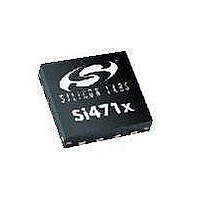Si4711-A20-GM Silicon Laboratories Inc, Si4711-A20-GM Datasheet - Page 24

Si4711-A20-GM
Manufacturer Part Number
Si4711-A20-GM
Description
RF Transmitter Broadcast FM Radio Trns w/RDS/RBDS
Manufacturer
Silicon Laboratories Inc
Datasheet
1.SI4711-A20-GM.pdf
(38 pages)
Specifications of Si4711-A20-GM
Lead Free Status / RoHS Status
Lead free / RoHS Compliant
Si4710/11-A20
Threshold/(Gain + Threshold).
example transfer function of an audio dynamic range
controller with the threshold set at –40 dBFS and a
Gain = 20 dB relative to an uncompressed transfer
function.
For input signals below the threshold of –40 dBFS, the
output signal is amplified or gained up by 20 dB relative
to an uncompressed signal. Audio inputs above the
threshold are compressed by a 2 to 1 dB ratio, meaning
that every 2 dB increase in audio input level above the
threshold results in an audio output increase of 1 dB. In
this example, the input dynamic range of 90 dB is
reduced to an output dynamic range of 70 dB.
The Si4710/11 includes digital audio dynamic range
control with programmable gain, threshold, attack rate,
and release rate. The total dynamic range reduction is
set by the gain value and the audio output compression
above
Threshold/(Gain + Threshold) in dB. The gain specified
cannot be larger than the absolute value of the
threshold. This feature can also be disabled if audio
compression is not desired.
Figure 20 shows the time domain characteristics of the
audio dynamic range controller. The attack rate sets the
speed with which the audio dynamic range controller
responds to changes in the input level, and the release
rate sets the speed with which the audio dynamic range
controller returns to no compression once the audio
input level drops below the threshold.
24
Figure 19. Audio Dynamic Range Transfer
–90
–80
= 20 dB
Gain
the
–70
M = 1
M = 1
–60
threshold
Threshold
= –40 dB
–50
Function
Input [dBFS]
–40
Compression
–30
Compression
2:1 dB
Figure 19 shows
No
is
–20
–10
equal
–10
–20
–30
–40
–50
–60
–70
–80
–90
0
Rev. 1.1
an
to
5.7. Audio Limiter
The audio limiter prevents over-modulation of the FM
transmit output by dynamically attenuating peaks in the
audio input signal that exceed a programmable
threshold.
programmed audio deviation + ten percent. The
threshold ensures that the output signal audio deviation
does not exceed the programmed levels, avoiding
audible artifacts or distortion in the target FM receiver,
and complying with FCC or ETSI regulatory standards.
The limiter performs as a peak detector with an attack
rate set to one audio sample, resulting in an almost
immediate attenuation of the input peak. The recover
rate is programmable to the customer’s preference, and
is set by default to 5 ms. This is the recommended
setting to avoid audible noise pumping or popping.
Please refer to “AN305: Si471x FM Transmitter
Programming Guide” for programming the audio limiter.
5.8. Pre-emphasis and De-emphasis
Pre-emphasis and de-emphasis is a technique used by
FM broadcasters to improve the signal-to-noise ratio of
FM receivers by reducing the effects of high-frequency
interference and noise. When the FM signal is
transmitted, a pre-emphasis filter is applied to
accentuate the high audio frequencies. All FM receivers
incorporate a de-emphasis filter that attenuates high
frequencies to restore a flat frequency response. Two
time constants are used in various regions. The pre-
emphasis time constant is programmable to 50 or 75 µs
and is set by using the TX_PREEMPHASIS property.
Figure 20. Time Domain Characteristics of the
Output
Audio
Audio
Input
Threshold
Audio Dynamic Range Controller
The
limiter
Attack
time
threshold
is
Release
set
time
to
the










